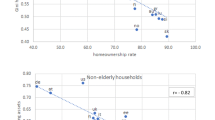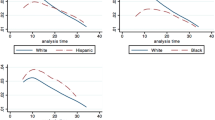Abstract
This paper examines the differences in homeownership between immigrants and native-born residents using the National Longitudinal Survey of Youth 1979 (NLSY79) data. We estimate the preference for homeownership and the amount of home equity held by households using a two-stage procedure. The results indicate that, although immigrants are less likely to be homeowners, immigrants who make the decision to own homes are more likely to have greater housing equity than native-born residents. About 66 to 70% of the disparity in homeownership can be explained by the difference in characteristics. The remaining disparity results from different homeownership functions estimated for the two groups. We discuss the implications of these findings for policy makers, real estate market researchers, and scholars of consumer behavior.
Similar content being viewed by others
Notes
The numbers are from the latest State of the Nation’s Housing Report from the Harvard Joint Center for Housing Studies
Zagorsky (1997, 1999) finds that the wealth and investment data contained in the NLSY data set correlates well with the wealth data in other major national databases such as the Survey of Consumer Finance (SCF), Panel Study of Income Dynamics (PSID), and Survey of Income and Program Participation (SIPP).
References
Adams, R. H. (2003). International migration, remittances, and the brain drain: a study of 24 labor exporting countries. World Bank Policy Research paper, 3069, 1–30.
Ameriks, J., & Zeldes, S. P. (2000). How do household portfolio shares vary with age. Unpublished manuscript, Columbia University.
Amuedo-Dorantes, C., & Pozo, S. (2002). Precautionary saving by young immigrants and young native-born residents. Southern Economic Journal, 69(1), 48–71.
Blinder, A. S. (1973). Wage discrimination: reduced form and structural estimates. The Journal of Human Resources, 8(4), 436–455.
Borjas, G. J. (1985). Homeownership in the immigrant population. Journal of Urban Economics, 52(3), 448–476.
Carroll, C. D., Rhee, B. K., & Rhee, C. (1994). Are there cultural effects on saving? Some cross-sectional evidence. Quarterly Journal of Economics, 109(3), 685–699.
Carroll, C. D., Rhee, B. K., & Rhee, C. (1999). Does cultural origin affect saving behavior? Evidence from immigrants. Economic Development and Cultural Change, 48(1), 33–50.
Cobb-Clark, D. A., & Hildebrand, V. A. (2006). The wealth and asset holdings of US-born and foreign-born households: evidence from SIPP data. Review of Income and Wealth, 52, 17–42.
Coulson, A. J. (1999). Market education: The unknown history. Social Philosophy and Policy Center, University of Washington.
Drew, R. B. (2002). New Americans, New Homeowners: The Role and Relevance of Foreign Born First-time Homebuyers in the US Housing Market: Joint Center for Housing Studies, Harvard University.
Dustmann, C. (1997). Return migration, uncertainty and precautionary savings. Journal of Development Economics, 52(2), 295–316.
Galor, O., & Stark, O. (1990). Migrants’ savings, the probability of return migration and migrants’ performance. International Economic Review, 31(2), 463–467.
Heckman, J. (1976). The common structure of statistical models of truncation, sample selection and limited dependent variables and a simple estimator for such models. Annals of Economic and Social Measurement, 5(4), 475–492.
Heckman, J. (1979). Sample selection bias as a specification error. Econometrica, 47(1), 153–161.
Kazarosian, M. (1997). Precautionary savings-a panel study. The Review of Economics and Statistics, 79(2), 241–247.
Keister, L. A. (2000). Race and wealth inequality: the impact of racial differences in asset ownership on the distribution of household wealth. Social Science Research, 29(4), 477–502.
Keister, L. A. (2003). Sharing the wealth: the effect of siblings on adults’ wealth ownership. Demography, 40(3), 521–542.
Larsen, L. J. (2004). The foreign-born population in the United States: 2003. Current Population Reports, 2004.
Lusardi, A. (1998). On the importance of precautionary saving motive. The American Economic Review, 88(2), 449–453.
Oaxaca, R. (1973). Male-female wage differentials in urban labor markets. International Economic Review, 14(3), 693–709.
Oaxaca, R., & Ransom, M. (1994). On discrimination and the decomposition of wage differentials. Journal of Econometrics, 61, 5–21.
Painter, G. (2000). Tenure choice with sample selection: a note on the differences among alternative samples. Journal of Housing Economics, 9(3), 197–213.
Preston, S. H. (1976). Mortality patterns in national populations. New York: Academic Press.
Robst, J., Deitz, R., & McGoldrick, K. M. (1998). Income variability, uncertainty and tenure choice. Regional Science and Urban Economics, 29(2), 219–229.
Turnbull, G. K., Glasscock, J. L., & Sirmans, C. F. (1991). Uncertain income and housing price and location choice. Journal of Regional Science, 31(4), 417–433.
Wang, C., & Hanna, S. D. (2007). Racial/ethnic disparities in stock ownership: A decomposition analysis. Consumer Interests Annual, 53.
Zagorsky, J. L. (1997). The NLSY79 wealth data evaluation. Columbus: CHRR, Ohio State University.
Zagorsky, J. L. (1999). Young baby boomer’s wealth. Review of Income and Wealth, 45(2), 135–156.
Zagorsky, J. L. (2005). Marriage and divorce’s impact on wealth. Journal of Sociology, 41(4), 406.
Zhong, L. X., & Xiao, J. J. (1995). Determinants of family bond and stock holdings. Financial Counseling and Planning, 6, 107–114.
Author information
Authors and Affiliations
Corresponding author
Rights and permissions
About this article
Cite this article
Chatterjee, S., Zahirovic-Herbert, V. Homeownership and Housing Equity: An Examination of Native- Immigrant Differences in Housing Wealth. Int Adv Econ Res 17, 211–223 (2011). https://doi.org/10.1007/s11294-011-9294-3
Published:
Issue Date:
DOI: https://doi.org/10.1007/s11294-011-9294-3




